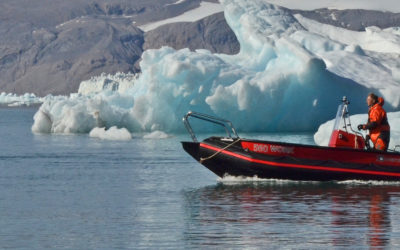
Arctic Station boating
The UK Arctic Research Station operates a PolarCirkel workboat. It is 5.6m in length with 100hp outboard engine, plus 9hp auxiliary outboard engine. It includes a fitted GPS suite and …
The UK Arctic Research Station is funded by NERC and managed and operated by British Antarctic Survey, and situated in the international research community at Ny-Ålesund on the high Arctic island of Spitsbergen, part of the Svalbard archipelago.

Reputedly the world’s northern-most community of up to 150 people, it has a unique atmosphere kindled by scientists of various disciplines and nationalities living, working and cooperating in a beautiful, though sometimes harsh, environment.
The Ny-Ålesund science village is a short flight from the nearest town, Longyearbyen. Flights operate on Mondays and Thursdays. In order to meet the Lufttransport flight connections from Longyearbyen to Ny-Ålesund (and on the return), an overnight stay en-route (in Oslo or Longyearbyen) is usually required. For all the information you need to make travel arrangements to the UK Arctic Research Station please visit the Travel and Accommodation pages of the NERC Arctic Office website.

Ny-Ålesund is owned by the Kings Bay Company who provide the community infrastructure including power and water supply, harbour facilities, air links to and from Longyearbyen and a shared dining facility.
The last remnant of the North Atlantic Drift produces a climate on Spitsbergen’s west coast milder than normal at that latitude; summer conditions compare with a British winter. The sun is down October to March and mid-night sun lasts April to August.
There are only three species of large mammal on Spitsbergen – polar bear, reindeer and Arctic fox. The chance of a sighting of any of these species is good but can never be guaranteed. However, marine species are more plentiful and include walrus, ring and bearded seal, white-nose dolphin, narwhal and orca. Belugas, fin and other whale species are also commonly sighted in the waters around Svalbard. In addition, over 100 types of birds, such as guillemots, kittiwakes and little auks thrive here, despite the high latitude.

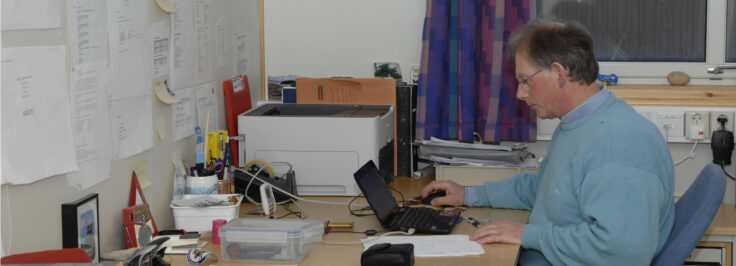
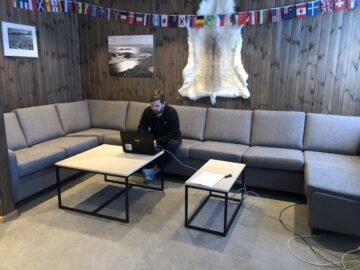
Field training and field support are provided on the base. Rifle training is a requirement and can be organised by the Station Manager. Further information on what to plan for when visiting the station can be found on the ‘Planning your fieldwork‘ pages.
All who visit the research station must also adhere to the BAS/NERC “Code of Conduct and Safety Policy”. A general safety briefing is provided at Ny-Ålesund on arrival at the Station. Please visit the Health and Safety pages of the Arctic Office website for more information.
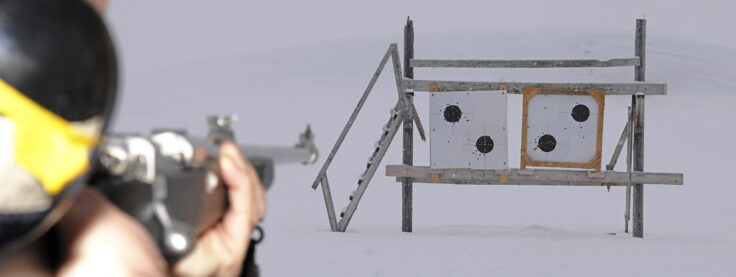
The UK Arctic Research Station is open for approximately four months each year from June to September although it can operate earlier (March/April) if required.
First sighted by the Dutch explorer Willem Barentz in 1596 the area was, by the early 1600s, a rich hunting ground for the bow head whale. Scientific exploration began in the 18th century. Post World War Two research, funded largely by oil companies, concentrated on the geology of the area.
The Svalbard Archipelago was a “No Man’s Land” until 1920 when a Treaty was signed (ratified in 1925) recognising the sovereignty of Norway. Original signatories included the UK, the Netherlands, Ireland, Italy, Sweden, Denmark, France, Italy and the USA. There are now more than 40 members. The terms of the Treaty exclude military activity and give equal rights to engage in commercial activity.
The UK has maintained a station in Ny-Ålesund annually since 1972. In 1991 the UK Arctic Research Station was established by the Natural Environment Research Council in 1991, when Ny-Ålesund became the focus of an international research community.
Ny-Ålesund provides a unique polar research environment that promotes cross-discipline research and international collaboration that advances understanding of global environmental issues. The international research community supports four flagship science programmes: marine, atmospheric, terrestrial ecology and glaciology. It provides facilities and accommodation for researchers from UK universities, research institutes and other recognised organisations (and their international collaborators) wanting to carry out environmental research relevant to the NERC science remit. If you wish to apply, please visit the Arctic Station pages on the Arctic Office website.
The total number of scientist days per year in Ny-Ålesund is approximately 14,000. The UK Arctic Research Station supports 10-15 research projects per year involving a total of 40-50 scientists.The station is an ideal place for PhD students to gain skills in polar fieldwork techniques, and we particularly encourage applications from accompanied students.
Limited international research is also carried out in Longyearbyen, primarily focussing on space physics.
Priority use of the Station is given to researchers funded by United Kingdom Research and Innovation (UKRI). The Station also welcomes those supported directly by universities and research centres or funded from other routes, such as the Leverhulme Trust, the European Union and similar sources.

The UK Arctic Research Station operates a PolarCirkel workboat. It is 5.6m in length with 100hp outboard engine, plus 9hp auxiliary outboard engine. It includes a fitted GPS suite and …
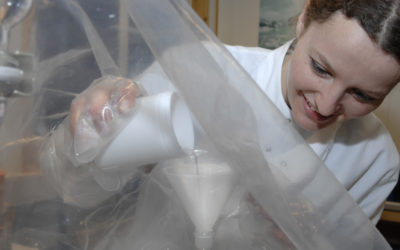
During the early part of the 2019 season, the Station laboratory underwent a major upgrade. This multipurpose facility comprises four separate laboratory spaces: Large main laboratory with wide benching and …
16 March, 2017 by Bianca Perren
This is not my average Arctic field season. Usually the months before departure are spent in a tiered state of preparation – getting field equipment ready and sending it North, …
11 September, 2015 by Mike Brian
Basically, it was riches beyond my wildest dreams. There’s nothing financial about it, but the feeling of a shower and knowing that your next meal will be a three course …
10 September, 2015 by Victoria Sleight
Hello! We are 16 students and early career scientists who had one thing in common: we do polar research, but had never been to the poles! Now that’s all changed and …
26 August, 2015 by Thomas Clay
Hello! This is the first blog about the upcoming NERC Advanced Training Short Course run by the British Antarctic Survey (BAS) between 26th August and 8th September 2015. We are …
24 November, 2022
Today, 24 November 2022, marks World Walrus Day, and British Antarctic Survey (BAS) and WWF are inviting the British public to become ‘walrus detectives’ and get involved in their Walrus …
13 July, 2022
Researchers are heading to the Arctic to begin fieldwork to study walrus populations for the next stage in the Walrus from Space project.
27 June, 2022
British Antarctic Survey (BAS) scientists will investigate critical challenges facing the UK, thanks to new funding from the Natural Environment Research Council (NERC). A £47m investment to several UK research …
11 March, 2019
The NERC Arctic Station in Ny-Ålesund, Svalbard, is delighted to be hosting the BBC Radio 4 Today Programme this week (12-14 March 2019), including science editor Tom Feilden and presenter …
28 March, 2018
This week scientists from University of Manchester have successfully tested their ‘metal-detecting’ technology at the UK NERC Arctic research station at Ny-Ålesund, Svalbard as part of a wider project to …
7 April, 2016
16 PhD students and Early Career Researchers have a unique opportunity to gain practical skills for working safely and effectively in the polar regions.
25 November, 2015
coordinating UK Arctic issues, research and logistics.
30 July, 2015
The Natural Environment Research Council (NERC) has announced it will invest £16m in research to study the effects of dramatic changes in Arctic ice cover over the last three decades on …
1 May, 2015
Digital Explorer launches virtual adventure on the ice at the UK Arctic Research Station The British Antarctic Survey is proud to support Digital Explorer’s second visit to the UK Arctic …
10 March, 2015
Extreme science in extreme conditions: frozen in to the Arctic winter Dr Markus Frey, a British Antarctic Survey (BAS) ice and atmospheric scientist, is living and working aboard the Norwegian …
17 October, 2013
New UK report shows that respect for Arctic states, local people and the environment is fundamental to Arctic engagement Today, for the first time, the UK Government has set out …
An estimated 75% of all the litter in our oceans is plastic, and around 5 million tonnes of plastic waste enter the ocean annually. Scientific observations of a significant concentration …
Deputy Station Manager